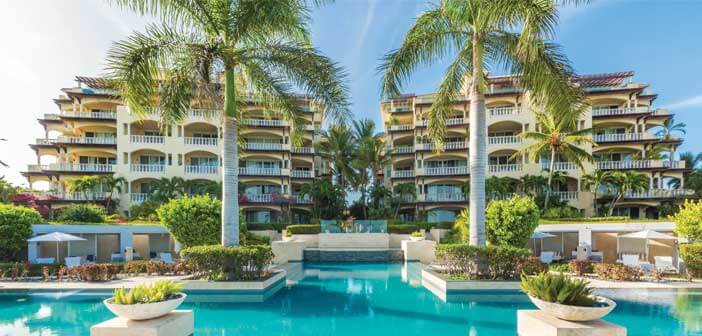With 330 days of sun on average, Turks and Caicos, an archipelago of 40 coral islands in the Atlantic Ocean, is an ideal vacation spot and has been attracting travelers and hotel developers for years.
“We are interesting,” said Nikheel Advani, COO/cofounder, Grace Bay Resorts and chairman, Turks and Caicos Hotel and Tourism Association, whose company has four properties in the British territory now and is building another in a joint venture that is scheduled to open in 2024. “We are not south enough where it becomes too warm, and we are not north where it becomes too cold. We are just at that year-round optimal temperature.”

Nikheel Advani, COO/cofounder, Grace Bay Resorts and chairman, Turks and Caicos Hotel and Tourism Association
When Advani first started developing hotels on the islands 20 years ago, tourism was only focused on the period from the winter holidays to Easter. “They would manage cash flow crazily until September, when you had your advance deposits,” he said. “I said, ‘If we’re going to do this, we’ve got to make this year-round.’”
He teamed up with airport authorities in the government and the hotel association to add inbound flights year-round. “Now, except for September, which is our slowest month of 40% occupancy, we run anywhere from 70% to 100% [the rest of the year],” he said.
When Advani first arrived, Turks and Caicos was on the cusp of when luxury hospitality started there, he said, adding, “Those were the days when you could recognize everybody’s car. We had one major road, and we didn’t have street lamps.”
Since that time, the local government focused on building the infrastructure needed to become a major tourist destination. “We didn’t have a hospital, and we have a world-class hospital now,” he said. “We’ve been growing so fast, in terms of infrastructure and business, as well as the private sector and the government making sure there are proper roads and an expansion of the airport.”
Advani said that the key to the growth as a tourist destination—especially a luxury destination—was getting the air traffic to the island. “The airlift dictates the volume that comes in and the quality of that volume,” he said. “You need a good section at the front of that plane.”
The territory also has two fixed-base operators (FBO) on one island to handle private jets. “That just gives you a sense of private-jet travel and the level of guests that we do have,” said Advani. “One of our largest client bases is from the New York metro area. For them, the island is safe, The island is low-density, high-end and has great food and beverages. It has the best beaches in the world.”
With this increased infrastructure, Turks and Caicos has been attracting developers with new properties open and under construction, including The Ritz-Carlton Turks & Caicos, The Bight Hotel and Andaz Turks & Caicos Residences at Grace Bay. “About five or six world-class developers who have developed in the Turks and Caicos before are carrying on and seeing that,” said Advani.
Grace Bay Resorts is in the process of building South Bank, a luxury marina development Advani said is a first of its kind for Turks and Caicos. “I think it’s going to cause some regional waves when we open because it is villa-heavy, with more than 30 private villas within the resort community,” he said.
In addition to these villas are a townhouses with marina facilities and the Arc by Piero Lissoni. “They are just the next level of what developments are doing where the outdoor spaces that he’s created are at the same square footage almost as the indoor spaces,” said Advani.
Despite having so many properties in the territory, Advani said that it is not an easy area in which to develop. “Logistically, you have to get everything in dealing with governments and that could take time,” he said. “We are a very sustainable island. Everything must go through proper processes. If you are doing anything on the water, you need special approvals and that can take a lot of time.”
The risks are high. “There could be hurricanes, and that could delay you three to six months,” said Advani. “With that experience of doing it for 20 years, we have had to build a lot of these contingencies within our performance, whether it’s the development side or the hospitality side, because we have both those businesses running concurrently.”
Like so many destinations around the world, tourism shut down for a period during the pandemic. But Advani said that the islands did a good job of getting back up and running quickly.
“It was a very tough situation for us,” he said. “But that is when you see leadership. What was great is during the good times, the private sector and the government had a great relationship. So, we had this advantage, we were not getting together for the first time to do something.”
That relationship was a key advantage. “We moved really fast,” said Advani. “The governor locked down the island with our advice and we worked hand in hand. We didn’t go up and down and change our protocols. We waited to get the right data.”
While the islands were closed for five months, they had a plan in place for safely welcoming tourists when they reopened. They created two startups. One was TCI Assured, an online portal created by the government where all international travelers (both visitors and residents) were required to obtain certification before traveling to the islands. The private sector created TCI Safe, which highlighted how to navigate the protocols in a seamless way.
“We made it easy,” said Advani. “With one click, travelers could buy a specific insurance that would get them a private jet to go back to the U.S. with all of the approvals needed, so the guest didn’t have to worry. We also didn’t have to overload our medical capacity on the island, which would be the only reason we closed again.”
Having these early systems in place brought tourists back—and helped them prepare as travel returned completely. “We were learning as we were going along,” he said. “The fact that we were open and ran about 15%-20% occupancy was the most valuable learning time. It got us practicing and seeing what the guests were comfortable with.”
Since the end of the pandemic, tourism—which represents 90% of the islands’ economy—has returned with a vengeance, with a 12.3% increase in occupancy from 2019. “We have been very fortunate since then, with the fundamentals being right on how we responded,” said Advani.


